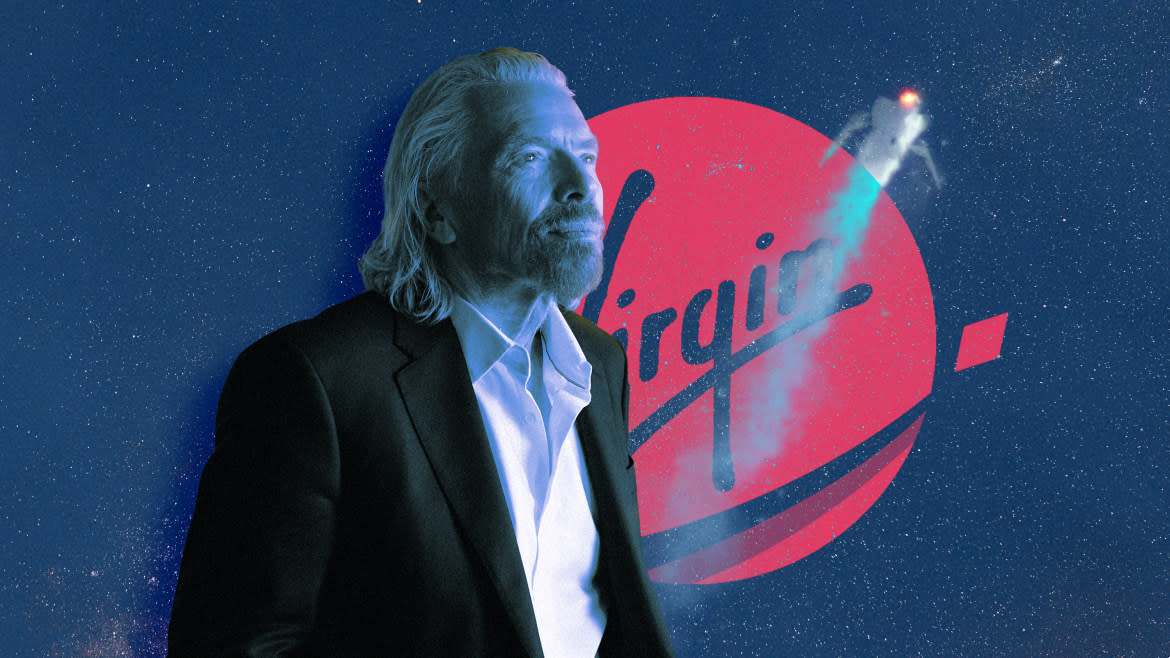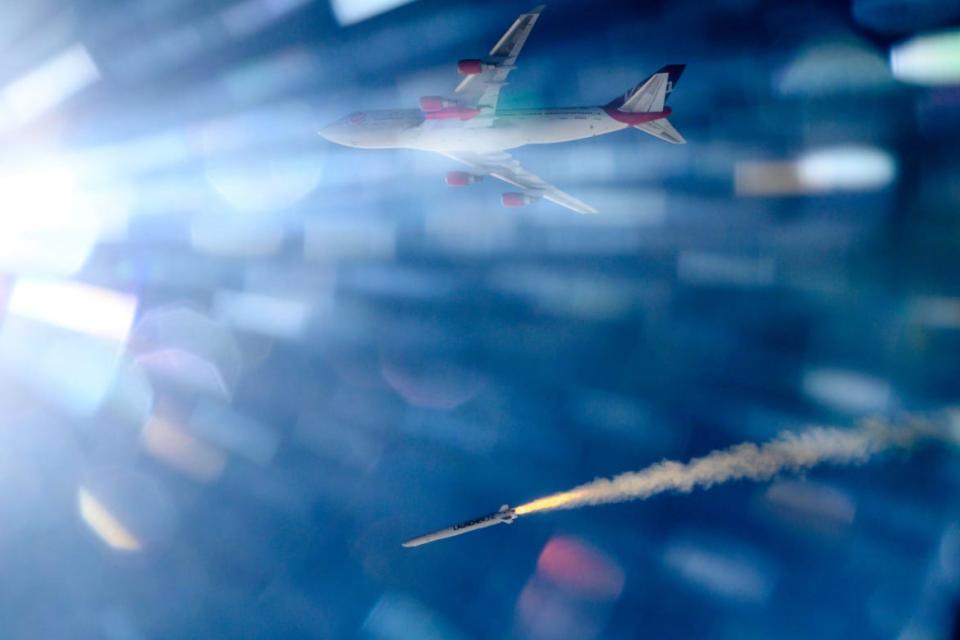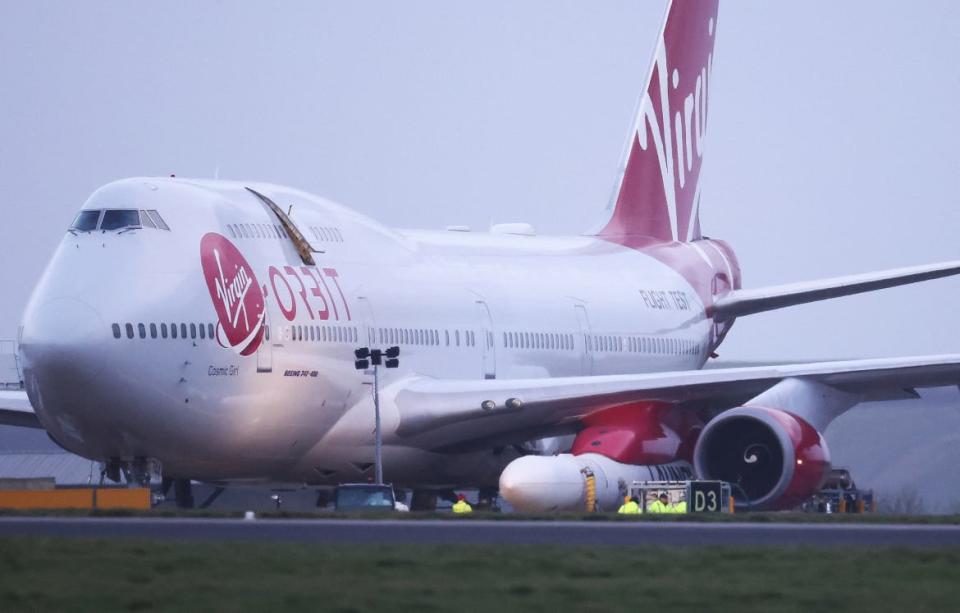Richard Branson’s Space Dreams Are Crashing Spectacularly

Shortly before midnight on Jan. 9, a camera on the Canary Islands operated by the Spanish Meteor Network caught a spectacular fireball plunging into the Atlantic Ocean. Although it looked a lot like a meteor, it wasn’t. It was a rocket with a payload of nine satellites burning up after failing to reach orbit.
Much more was burning up than a lot of expensive rocketry and cargo. The rocket had been launched not from the ground, but from high up over the Atlantic from a converted Boeing 747 jumbo jet bearing the somewhat raffish moniker of Cosmic Girl, operated by Richard Branson’s company Virgin Orbit. Within minutes of the failure being livestreamed to the world, the company’s shares lost almost a quarter of their value.
Now Virgin Orbit has declared bankruptcy, ceased operations, and laid off most of its staff.
The Jan. 9 mission failure was also an acute embarrassment for the U.K.’s space agency. The country has never had its own launcher program. It hitched its future prospects for a “gateway to the stars” to Virgin Orbit by approving the mission, named Start Me Up, from a new spaceport in Cornwall, the western peninsular considered ideal for British launches over the Atlantic. The nine satellites lost included four that were part of advanced programs being run by U.S. and U.K. military labs and the first satellite built by the Gulf state of Oman.
Richard Branson’s Space X Rival Virgin Orbit Files for Bankruptcy
Virgin Orbit was an early entrant in the market for micro-launchers, far smaller rockets than those needed for the larger, heavier payloads required by military and commercial satellite networks. The company was spun-off in 2017 from Virgin Galactic, Branson’s pioneering but costly space tourism project, at the initiative of engineers who saw the new market as a far faster route to profits.
And it is that provenance that, with the meltdown of Virgin Orbit, renews the long-simmering question about whether Virgin Galactic, a world leader in deadlines missed, budgets busted and a string of promises never met, will ever get close to delivering the nirvana of space travel for the filthy rich that Branson has relentlessly hyped. (Galactic claims a backlog of 800 “astronauts” waiting to ride at $450,000 a pop).
The underlying problem is that Galactic and Orbit shared the same fundamental concept for launching rockets: air launch. Instead of launching from a static pad, the launches were from airborne motherships at heights of 40,000 feet or more. That removed the need for huge booster rockets needed to accelerate from ground level to the stratosphere. In the case of Galactic, this enabled crewed flights into suborbital space; and of Orbit, for delivering small satellite payloads into orbit.

Virgin Orbit's Boeing 747 carrier plane releases the company's LauncherOne rocket.
Air launch was the brainchild of a maverick aeronautical genius, Burt Rutan. He designed and built the first privately funded manned vehicle to reach space, SpaceShipOne, in 2004, at a cost of $25 million provided by the Microsoft co-founder Paul Allen. SpaceShipOne was launched from a mothership, blasted to the edge of space and glided back to Earth. Then along came the buccaneering Branson, with a lot less money and technical grasp than Allen but a lot more hubris and showmanship. Partnering with Rutan, SpaceShipOne became the genesis of Virgin Galactic.
Branson and the company promised the first passenger flight would take off by 2007—a milestone that was only finally achieved in July 2021 when Branson himself rocketed into space with two pilots and three Galactic executives. But then, as with so many previous Galactic flights, it turned out that there had been a serious glitch. The pilots had narrowly avoided an emergency landing after the craft swung off its designated course.
There was an FAA investigation into what happened during the mission and a little over two months later, it grounded Virgin Galactic. As well as the glitch on the spacecraft, a structural weakness was discovered at the point on the wing of the mothership where SpaceShipTwo was anchored before being released.
Branson’s flight, covered worldwide by a largely gullible media, took place only nine days before rival Jeff Bezos made it into space riding his Blue Origin company’s New Shepard rocket. After Branson’s flight his flight director declared “everything was perfect in real time… there were no issues whatsoever.” Not only was that not true, but when the FAA grounded Galactic the impression was left that Branson had pressured his engineers to clear the flight in order to best Bezos. (Galactic issued a statement denying this.)
As it turned out, serious flaws were discovered. The grounding lasted 18 months. The mothership, Eve (named after Branson’s mother), needed new horizontal stabilizers as well as the fix to the anchor point. Now Eve is back at Spaceport America in New Mexico, preparing for a series of test flights carrying one of the two available SpaceShipTwo ships, Unity. Work on the other, Imagine, is being slow walked.
Imagine is the right word. All of this reflects a serious disconnect between the frequent hyped announcements of a future fleet of more advanced ships regularly lofting “space tourists” to the edge of space and the hard reality of what remains a prolonged experiment to prove the concept.
The coming test flights will begin cautiously, with Unity being dropped for an unpowered glide to Earth. After that, a rocket-powered ride to a height of around 53 miles above the planet with pilots and technicians will have to satisfy the FAA that all the systems are safe for passengers. Waiting for that to happen is a team from the Italian Air Force, who were originally scheduled to fly in October, 2021, and are hoping to fly early this summer. Galactic touts this to promote another role for its ships as supersonic laboratories for scientific experiments.
Richard Branson’s Virgin Galactic Has One Very Big Problem
The chances of raising new funding for the promised new generation of ships, known as Delta, are shrinking by the week. In 2021, Galactic’s worth, in market capitalization, was $13.9 billion. It’s now down to $969.7 million and falling. The company has burned through $400 million in the past year. It probably has enough to operate for another two years with the existing vehicles. Even then, it would have to reach a rate of one flight a month just to wipe out losses, and that seems a very long shot.
Finding new backers has been difficult. Galactic and Orbit both raised funding by going to the market using the fleetingly fashionable device of a special purpose acquisition, SPAC, otherwise known as the blank check offering, where the normal stock exchange scrutiny of an independent public offering was evaded and investors were asked to accept in good faith wildly optimistic profit forecasts.
Galactic’s debut on the New York Stock Exchange in October, 2019 produced a cascade of typical Branson BS. Not long afterward, both he and his partner, SPAC disciple Chamath Palihapitiya, were dumping the stock, and Palihapitiya told the Financial Times: “In hindsight, I probably didn’t need to do it, but at the moment it seemed the right thing to do.” At launch the stock price hit nearly $60. It’s now at $3.12 as of April 6. Orbit’s SPAC offer aimed to raise $500 million. It ended up with less than half of that.
Orbit, from the start, was undercapitalized for the gamble it was taking, not only by choosing air launch but, for the first time, using a jumbo jet (retired from Virgin Atlantic) as the platform. (Previously, the only spacecraft specifically built for sending satellites to orbit via air launches was the world’s largest airplane, the Stratolaunch, dreamed up by the aforementioned Paul Allen who died in 2018, a year before it first flew. So far this mammoth has flown only three times and its fate is uncertain.) Since 2020, Orbit flew only six missions, two of which failed and the remainder of which delivered only 33 satellites into orbit.

Cosmic Girl, a Virgin Boeing 747, sits on the tarmac with Virgin Orbit's LauncherOne rocket attached to the wing at Spaceport Cornwall in Newquay, Britain, Jan. 9, 2023.
But money wasn’t the only problem. Three of the top executives, including the CEO, Dan Hart, were recruited from Boeing, where the management of space projects has been the worst in the industry (the least innovative and never meeting a budget or deadline), allowing Elon Musk’s SpaceX to become the industry leader. When Orbit was shuttered, CNBC quoted several engineers who complained about poor management and leadership and, particularly, that when Hart delivered the bad news he did so virtually, not face-to-face, which echoes the style of Boeing’s top managers.
In any event, Orbit may well be another case of the first ending up last: the market for launching clusters of small satellites into low Earth orbit has grown so fast that at least eight European startups are developing micro-launchers specifically for this purpose. New technology has cut the price of entry and the miniaturization of satellites marries with the shrinking of conventional launchers to meet a demand that can’t be met by the huge launchers of traditional rocket makers like Arianespace in Europe and ULA in the U.S..
However smart the engineers and managers of the Virgin projects are, they seem to have been unable to overcome the persistently formidable barrier to success presented by air launch. It multiplies the technical problems because it combines two inimical aerodynamic environments: the subsonic and the supersonic. A single booster rocket (the direct descendant of Hitler’s ballistic missile, the V2, and the NASA launchers that followed) is an extremely challenging work of engineering on its own, with myriad small components that could fail. The Virgin companies have attempted to marry that technology with what is basically, in the case of Galactic, a small corporate jet.
Rutan’s SpaceShipOne was a ballsy and beautiful machine. But it was far closer to the high-risk audacity of NASA’s Apollo moon missions, still essentially analog, than to the far more sophisticated technology of this century. In the same way, the beauty part of the Galactic concept is its three-stages of experience for the passengers—subsonic climb to launch altitude, white-knuckle rocket ride ending with a few rapturous minutes of weightlessness, and a glide back to Earth in silence with the time to contemplate the view and the meaning of life.
That whole flight lasts around one hour and 10 minutes. A ride in the nose capsule of Bezos’ New Shepard lasts 10 minutes, including a NASA-like descent with the capsule dangling from parachutes and, instead of splash-down, a final puff of power to brake for a soft landing in the Texan desert. It’s a purely ballistic flight, without the elegance of subsonic flight to frame it. But it will surely be the winner in the marketplace for suborbital joy-riding because it has already proved to be far more dependable. (Riding as a passenger in a SpaceX capsule orbiting the Earth for a couple of days beats everything else but will only ever be for one-percenters.)
Branson’s magical thinking was that he would open the way for suborbital space travel with the regularity and dependability of an airline schedule. The problem was that, in air launch, he chose a technological blind alley. And, in a strange way, that hubris echoes the story of the founding visionaries of flight, the Wright brothers.
The Wrights also flew up a blind alley, with the kite-based configuration of their flying machines. They failed to see and develop the full potential of their amazing invention by stubbornly sticking to a form of airplane that quickly became obsolete, the biplane, reflecting a box kite, with a horizontal stabilizer ahead of the wings, a form called canard, instead of mounted behind at the end of a fuselage.
The U.S. Army was the first customer for the Wright machines, and stuck with them for years, until generals complained that they had a “hidebound determination to stick to their original form.” As a result, the U.S. entered World War I with fewer than 200 primitive machines while the Europeans, who had taken their own innovative path, dominated the skies. In 1916, the Wright business was merged with the Glenn L. Martin company, forming the Wright-Martin Aircraft Company, forerunner of today’s Lockheed Martin. So at least one blind alley eventually opened up to the future.
Get the Daily Beast's biggest scoops and scandals delivered right to your inbox. Sign up now.
Stay informed and gain unlimited access to the Daily Beast's unmatched reporting. Subscribe now.

 Yahoo News
Yahoo News 
